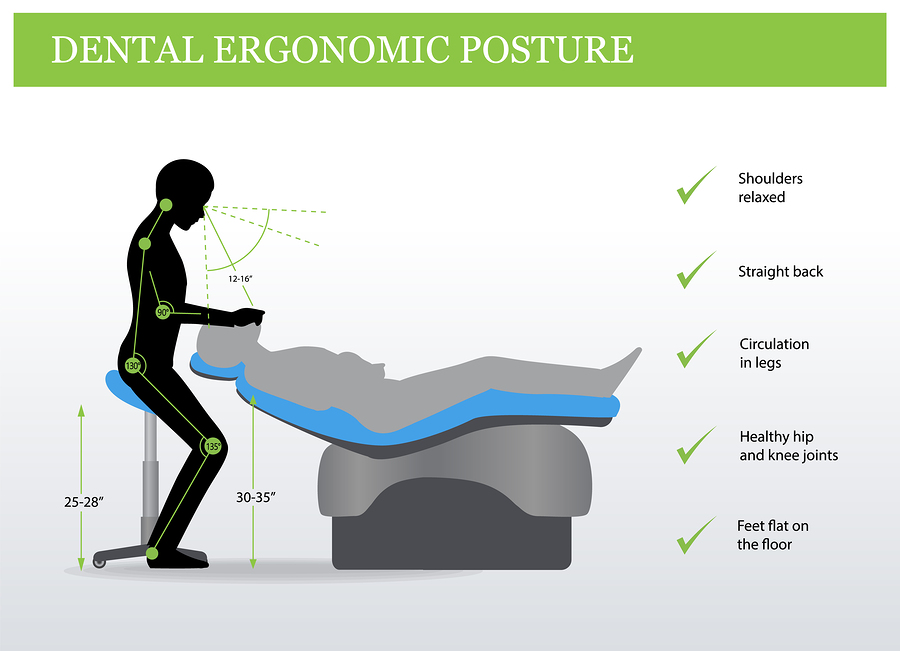Why is Ergonomics Important in Dentistry?
Posted by HJT Design

As a dentist, you probably spend lots of time delivering quality care to patients. Such care involves maintaining awkward positions to access the mouth area. For example, you may find yourself leaning over for extended periods, having your arms in a twisted orientation, or straining your eyes to maintain proper vision.
Improper positioning can lead to various dental ergonomic issues. It’s not uncommon for dentists to end up with a strained back, craned neck, or stiff fingers. This is why oral health professionals should take ergonomics in their workplace seriously.
Ergonomics is the process of designing your workplace to ensure optimal efficiency for daily operations. In other words, a proper dental ergonomics plan allows you to avoid risk factors to your health while delivering higher quality care.
Consequences of Poor Dental Ergonomics
In most cases, dental professionals struggle with ergonomics because they’re looking for a better viewing angle. The result is dentists craning their necks, backs, and arms so they can see what’s going on inside a patient’s mouth. Improper ergonomics may result in many different consequences, some of which include:
Back Pain
Back pain is a common issue in workplaces, and dentists are particularly affected by lower back strains. This is because improper ergonomics causes dental professionals to lean forward for extended periods during the day. Furthermore, using the wrong type of chair (positioned at the wrong angles) may further cause you to strain your back muscles.
Musculoskeletal Complications
In addition to lower back straining, you may also experience musculoskeletal complications. These include rotator cuff strains/tears, stiffness in your fingers, elbow pain, and even carpal tunnel syndrome.
Improper Vision During Treatment
Improper dental ergonomics can also affect a dentist’s eyesight. This is because you may spend hours every day straining to maintain proper vision inside a patient’s mouth. Straining causes your eyes to become worn out faster than usual, resulting in focusing issues. You may also have additional sensitivity to glare in different environments.
Tips for Making Your Dental Practice Ergonomically Friendly
In light of the risks mentioned above, you may be wondering how to protect your health while maintaining high standards of service to patients. Here are several tips for proper dental ergonomics.
Maintain Proper Positioning During Treatment
The most obvious step is to ensure that you maintain proper positioning over your patients. The chair you use should encourage an upright posture and be flexible enough for multiple treatment angles. Furthermore, your chair should be comfortable enough for you to sit on during lengthy clinical procedures.
Position your chair as close as possible to the patient and distribute weight in your hands as evenly as possible.
Keep Patients in the Right Position
For lengthy clinical procedures, patients should be encouraged to sit in a reclining chair. The reclining angle should be gentle, and the chair should have a flexible cushion for added comfort. The goal is to minimize your need to lean forward, crane your neck, or extend your arms.
Remodeling Can Help
Perhaps the most important part of ergonomics is having the right equipment and office design in place. Most dental professionals who struggle with muscle pain experience discomfort due to poor office design.
This is why you should consider having your office remodeled for efficiency and comfort. From proper lighting (to improve illumination) to having the best patient chairs installed, a remodel gives you the opportunity to start fresh while designing your office for success. Furthermore, proper dental ergonomics will ultimately improve patient care while keeping your own health for years to come. We have the experience and knowledge necessary to evaluate your current dental office space and help you design and build one that better suits your needs. Contact us today to learn how our decades of experience can bring so much more to your project.